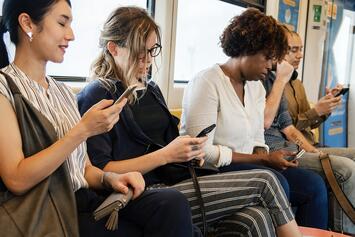
On a recent visit to London, my phone did not connect to the networks abroad when I landed. Within seconds, I was filled with anxiety; as someone who is constantly texting, using social media, and consuming information on my device, I felt empty and exposed and couldn’t let loved ones know that I made it over the pond. I had visited London on many occasions and knew exactly where I was going, but being disconnected felt awkward and isolating and I was truly uncomfortable as I made my initial way from Heathrow into central London. While en route, however, my unease began to abate. After about thirty minutes, I was overtaken by a feeling of euphoria that I had not felt since years ago when constant connectivity was not the norm and I had to interact with the real, physical world around me as opposed to consuming a constant flow of stimulus from a tiny screen.
Well over a decade ago, when I would visit a place other than home, I talked to as many others as I could, I did not rely on various sites and social media companies to tell me where to go and what to see, and I did not feel the need to check in and document every moment of my experience—I was living in and paying attention to the world and people around me rather than a small screen in front of me. I had this experience once again in London, where I managed to talk to so many and hear some amazing life stories in public and third-place settings as varied as pubs to the tube, on a host of experiences ranging from the then-upcoming Queen’s Jubilee and geopolitics to the unusually warm British weather and the football season. While many were surprised that I was not staring at my phone with a headset on and actually wanted to talk, after some initial shock, most were quite happy to open up. I felt connected to others and places in a way that I had not for quite some time. And despite missing various “insider tips” from digital sources, a sense of wonder, opportunity, and joy returned for the day I had no phone service.
The next day, I was able to fix my SIM card and suddenly resumed my usual habits of fixating on my phone rather than the people and places around me. Although I was riding a different transit system and eating or shopping in vastly different locales, my use of the phone actually kept me cocooned and isolated from real people and experiences. Of course, this is not to say that there is no real value to digital products and technology, nor that socialization and connections are not improved in some cases by virtue of omnipresent connectivity. But having a working smartphone changed how I was thinking about London and its streetscape and how I engaged with the many others around me. I was still in London, but the sense of spontaneity—a bit of danger and unknown—and being able to connect and explore changed; I was notably less social and less open to connecting with others.
I share this experience because so many—from academics to public officials—are concerned with how to reinvigorate the civil sphere and rebuild communal social capital in this era of division and polarization. One simple step that could help create connections to space, place, and people would be to put one’s phone down and actually talk to others and experience life in various settings. This statement has nothing to do with the polarizing views and echo chambers of social media—although that remains a huge problem that impacts our discourse and ideas about our fellow Americans. Rather, it is a call for pausing our addiction to technology and being online at all times. We need to look up and speak with others in real space and time, where we can create more meaningful connections, share ideas outside of 180-character tweets, and perhaps find common ground and shared humanity as I did for a brief moment of cellular disconnection in London.
Read the rest of this piece at AEI.
Samuel J. Abrams is a professor of politics at Sarah Lawrence College and a nonresident senior fellow at the American Enterprise Institute.
Photo: Rawpixel, under CC 2.0 License.












